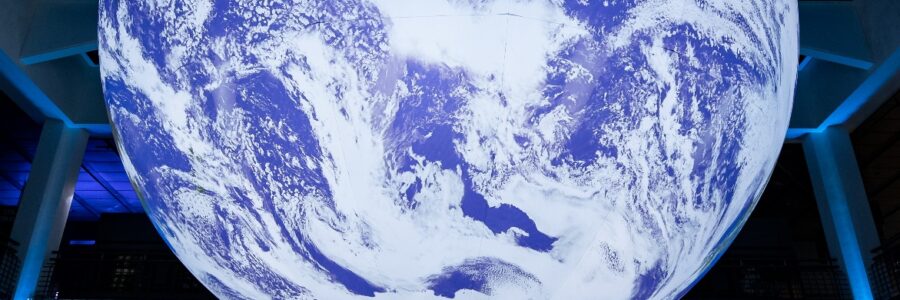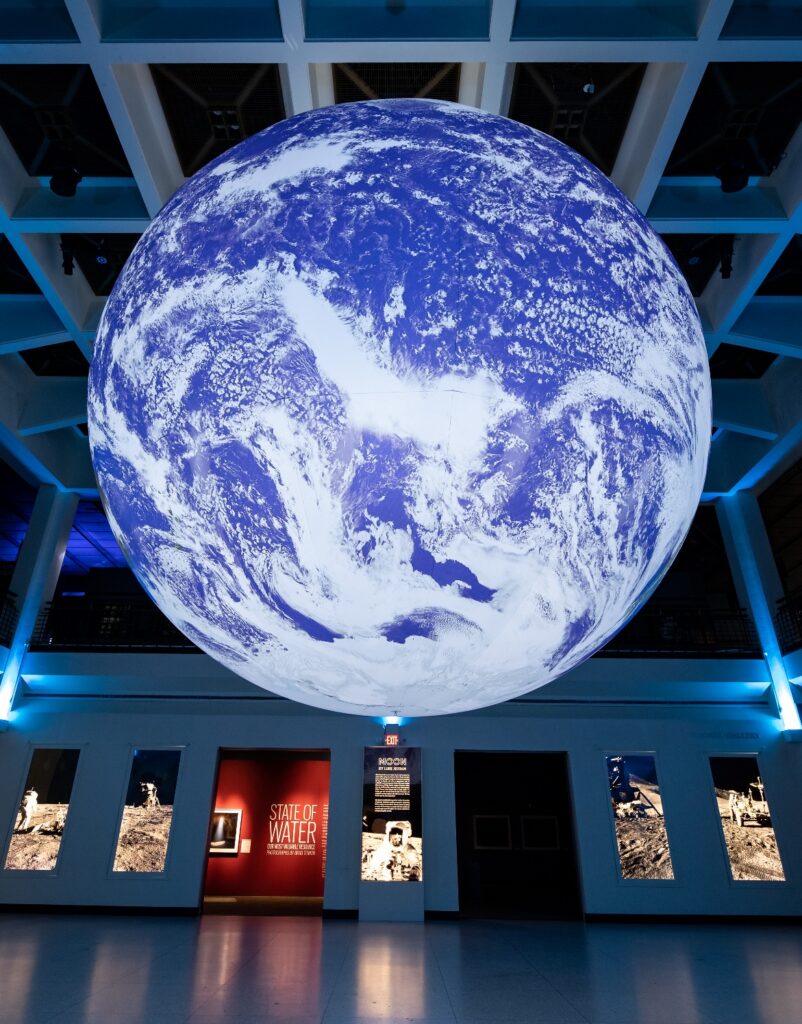
New Earth Exhibit Rising at the Houston Museum of Science
For a Limited Time, May 15 through June 30
A new sculpture by British artist Luke Jerram rises at the Houston Museum of Natural Science and is an internally lit, 23-foot in diameter sphere resembling our planet Earth
For over a year, guests who entered the Houston Museum of Natural Science were greeted by a phenomenal sight—Moon by Luke Jerram, a gigantic, internally lit lunar sculpture that looked like the Moon had been plucked out of the sky and hung in the museum’s Glassell Hall. Guest-favorite British artist Luke Jerram returns to HMNS with Gaia – Earth by Luke Jerram, opening for a limited time May 15. The 23-foot diameter sculpture replaces the Moon, bringing guests the wonder of seeing their own planet floating above their heads.

The awe that comes with seeing the planet we call home from this perspective is so powerful that the seldom experienced phenomena has a name: the Overview Effect.
Unlike the Moon, which we have been gazing at for millennia, the first time humankind got to see the Earth in its entirety as a blue marble floating in space was in 1972 during NASA’s Apollo 17 mission. The idea of the Overview Effect was later described by author Frank White in 1987. Astronauts are some of the only people lucky enough to experience this powerful effect, until now. Jerram’s work aims to recreate this sense of awe for all viewers.
“I was amazed and delighted that my Museum of the Moon artwork has been so popular. I’m fully aware that 4 million members of the public haven’t been coming to see an artwork by ‘Luke Jerram’ but rather ‘the Moon’; an object of universal appeal and cultural significance,” Artist Luke Jerram said. “With this Gaia Earth artwork, I’m interested in just how different the experience and interpretation is. For our entire human existence we have been gazing up at the moon and projecting all our hopes, dreams and wishes up there. Whereas it was only in 1968 that we were able to [first] see our planet floating in space.”
Measuring 23 feet in diameter, Gaia features 120dpi detailed NASA imagery of the Earth’s surface. The artwork provides the opportunity to see our planet on this scale, floating in three dimensions. The artwork is 1.8 million times smaller than the real Earth, and each inch of the internally lit sculpture describes 4.4 miles of the Earth’s surface. Visitors will get a much closer view than astronauts – at this scale, one would have to stand 700 feet away from the artwork for Gaia to appear the same as Earth appears from the Moon.
“After the Apollo astronauts saw the Earth from space, Archibald Macleish produced a quote that has stuck with me for 50 years, ‘To see the Earth as it truly is, small and blue and beautiful in that eternal silence where it floats, is to see ourselves as riders on the Earth together, brothers on that bright loveliness in the eternal cold — brothers who know now they are truly brothers,’ ” HMNS Vice President of Astronomy Dr. Carolyn Sumners said. “Perhaps it is most important now as we unveil our Earth. We have country lines on our column maps, but there are no lines on our globe. It’s sad that we have had to learn this lesson again from a tiny virus.”
The imagery for the artwork was compiled as a part of NASA’s Visible Earth series. The project, called Blue Marble Next Generation, turns satellite data into digital images with a spatial resolution of 500 square meters per pixel.
The work is named for the personification of our planet in Greek mythology. Before there was Mother Earth, there was Gaia who birthed the Titans—the fathers of the gods—and bore forth the sky, mountains and sea.
The exhibit space surrounding Gaia educates visitors on the Earth’s various spheres: geosphere (land), hydrosphere (water), cryosphere (ice), atmosphere (air) and biosphere (life). The interactions of the spheres, which have occurred since the birth of the planet, make Earth a dynamic home for life.
Gaia – Earth by Luke Jerram is on display beginning May 15 through June 30, 2020. Included with admission to the permanent exhibit halls and located in the Alfred C. Glassell Hall. Presented by Phillips 66, Gaia has been created in partnership with the Natural Environment Research Council (NERC), Bluedot, the UK Association for Science and Discovery Centres, Culture Liverpool and Liverpool Cathedral.